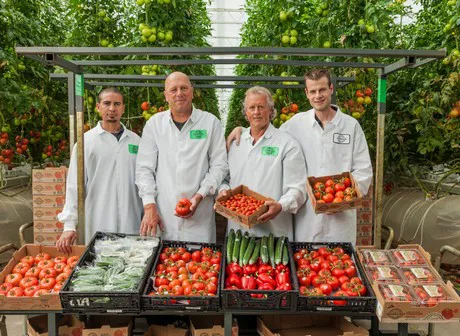Innovating is beautiful, but it does not always happen because often there is no real necessity. That necessity was there for the American grower Casey Houweling, as he told during the innovation seminar by Royal Brinkman. Over the years, each time a more southern-situated company was added to Houweling, and that required innovation. "We have never been afraid to take risks."
 Casey during the innovation seminar by Royal Brinkman. The complete report of this event can be read here.
Casey during the innovation seminar by Royal Brinkman. The complete report of this event can be read here.
Casey started growing with a 2.5 hectare greenhouse in Canadian Britisch Columbia in 1985. With that 2.5 hectare, it was the largest greenhouse in the region at that time. After a visit to the Netherlands, where he saw for the first time how cultivation was carried out there - an eye opener - things were set in motion.
It snowed white flies
The climate in British Columbia required the grower, who had a large drive to expand, to look even further down south. Cultivation in Canada is restricted to eight months per year, and Casey wanted more. What followed was the step to Mexico, but that quickly turned out to be a fiasco, because Mexicans were only allowed to buy tomatoes from own soil during winter. Moreover, it 'snowed' in such a manner, not the snow we know here and in Canada, but lots and lots of white flies, which made proper cultivation very hard.
Casey turned to California in 1986, where he found the ideal cultivation climate and where he introduced insect gauze. It was not immediately successful, because during the first attempt they forgot to add a UV-resistant agent to the gauze. The gauze did not last long and the crops were lost.
From insect screen to Ultra-Clima greenhouse
Thanks to support from the bank, Casey had the opportunity to make a new innovation attempt. Because the insect gauze reduced the light quantity in the greenhouse by twenty up to thirty percent, he started thinking about a greenhouse without insect gauze. The rest is history by now, because the semi-closed Ultra-Clima greenhouse had seen the light. The last sixteen hectare in California was filled with this type of greenhouses, in which insect do not have any opportunity to get because of over-pressure.
A third plot of land was then purchased, this time in the American State of Utah. To give an example, this is at the same latitude as Madrid, and a bit more north than the greenhouses in California, which are at the same latitude as the Moroccan Marrakesh. In Utah, Casey had to deal with a land climate with huge differences in temperature. From minus twenty degrees Celsius to plus forty, anything is possible. The desert climate is a challenge, but growing in Utah also has advantages. The population is very proud, and this turned out to be a marketing advantage.
Dealing with viruses
There is also innovation in the field of marketing. By now, Houweling's has a large marketing team. And that is necessary, according to Casey, because the increasingly smaller margins force a grower to distinguish himself. The sale of tomatoes (and cucumbers, a cultivation technical decision) is also done by Houweling's: "As a grower, you cannot afford to 'give away money' to intermediaries if the margins are so small."
Just like in the Netherlands, because the comparison between cultivating in the Netherlands and in North-America is often made, Houweling's too is dealing with the usual cultivation and labor problems. As a solution against the Pepino mosaic virus, the cultivation of tomatoes and cucumbers were alternated. The in-between period keeps Houweling's free from cucumber as well as tomatoes viruses.
Investing, cannabis, and succession
Labor is also a problem. The law in effect states that people are allowed to work less hours in the United States: a challenge. Casey suggested that private equity might be a solution (Equilibrium invested in the company at the end of 2018 to make steps), but growing cannabis could also be a solution, Casey jokingly said, but with a serious undertone in light of the rest of the innovation seminar, which also addressed the cultivation of cannabis.
 "Although not all growers have children, they are like fathers to everything growing in the greenhouse", was the message on the Facebook page of Houwelings during Father's Day.
"Although not all growers have children, they are like fathers to everything growing in the greenhouse", was the message on the Facebook page of Houwelings during Father's Day.
Anyway, who is going to grow in the future when Casey will not? It turns out to be Casey's middle daughter. "My daughter is already working in the company and is very interested."
Check out the Houweling's website, which, for example, lists some innovations made by the company, such as innovation in the field of energy.
